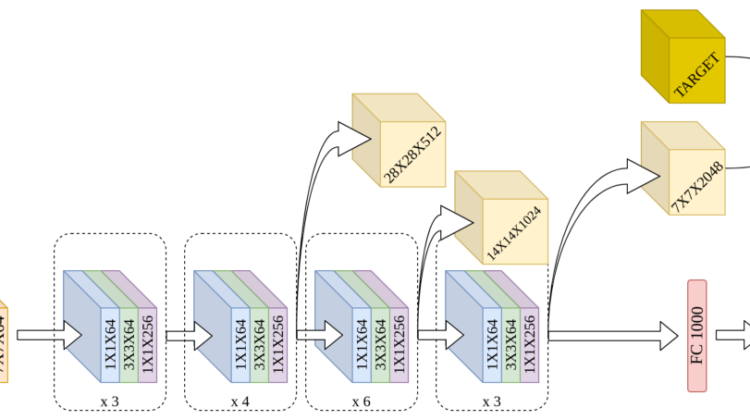
We create an instance of the model like this
model = NewModel(output_layers = [7,8]).to('cuda:0')
We store the output of the layers in an OrderedDict and the forward hooks in a list self.fhooks. We enumerate over the layers in the pre-trained model and if the index of the layer matches with the numbers we passed as argument to the model, then a forward hook is registered and the handle is appended to the list self.fhooks. The handles can later be used for removing the hooks from the model. The hook simply creates key-value pair in the OrderedDict self.selected_out, where the output of the layers is stored with a key corresponding to the name of the layer. However, instead of the layer names, the index of the layer can also be used as keys.
The output obtained from the intermediate layers can also be used to calculate loss (provided there is a target/ground truth for that) and we can also back-propagate the gradients just by using
loss.backward()
Let, us create a random array with the same dimensions as ‘layer4’ (7th layer).
target_ft = torch.rand((2048,7,7), device = ‘cuda:0’)
Let, us take an input (any random natural image will do)
x = imageio.imread(‘image_path’)
x = (x-128.0)/128.0
x = resize(x,(224,224),preserve_range = True)
x = np.repeat(np.expand_dims(x,0),8,0)
x = torch.movedim(torch.Tensor(x),3,1)
Output
out, layerout = model(x.to(‘cuda:0’))
Now, layerout is an OrderedDict. We need to get the output from layer4 from it. We can easily do that since the layer name is the key
layer4out = layerout[‘layer4’]
Let us create a dummy loss function first. Suppose, the loss is like this
loss = torch.sum((label-out)**2) + torch.sum(layer4out-target_ft)
Last step
loss.backward()
We can use forward_pre_hook.
Let us look at an example
First, add this method to the NewModel class
The function pre_hook can be modified as per requirements. Here, I am setting the input to an all-zero tensor. In addition to that, I have added two print statements before line 17 in the code for NewModel and also before line 3 in the code for the forward_pre_hook (above).
print(input)
The print statement in the forward_pre_hook prints (as it is executed before the forward method of grad_fn)
tensor([[[[0.1342, 0.0525, 0.0210, …, 0.2578, 0.2857, 0.1806],
[0.1682, 0.0721, 0.1772, …, 0.2345, 0.2021, 0.0656],
[0.1483, 0.1108, 0.0943, …, 0.1353, 0.1450, 0.0922],
…,
[0.0526, 0.0000, 0.0000, …, 0.2418, 0.1614, 0.0844],
[0.1251, 0.1400, 0.0840, …, 0.1964, 0.1850, 0.0707],
[0.0000, 0.0752, 0.1551, …, 0.1493, 0.0917, 0.0000]],
The print statement in the forward_hook prints
tensor([[[[0., 0., 0., …, 0., 0., 0.],
[0., 0., 0., …, 0., 0., 0.],
[0., 0., 0., …, 0., 0., 0.],
…,
[0., 0., 0., …, 0., 0., 0.],
[0., 0., 0., …, 0., 0., 0.],
[0., 0., 0., …, 0., 0., 0.]],
Also the output out has changed
Before input modification
tensor([[-1.2440, -0.3849, -0.6822, …, -0.7914, 0.9842, 1.1522]],
device='cuda:0', grad_fn=<SqueezeBackward0>))
After input modifcation
tensor([[-0.9874, -0.2133, -0.5294, …, -0.4161, 0.9420, 0.7546]],
device='cuda:0', grad_fn=<SqueezeBackward0>))
